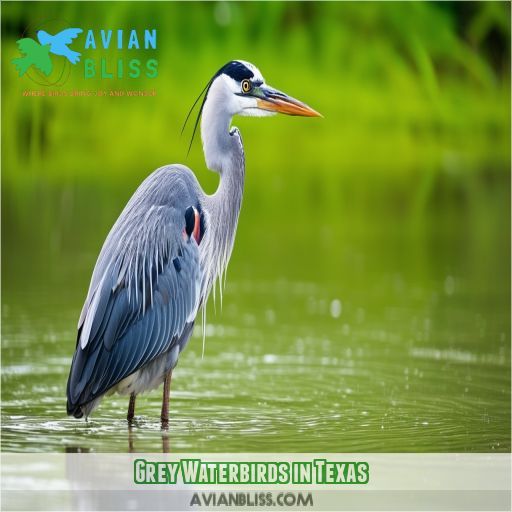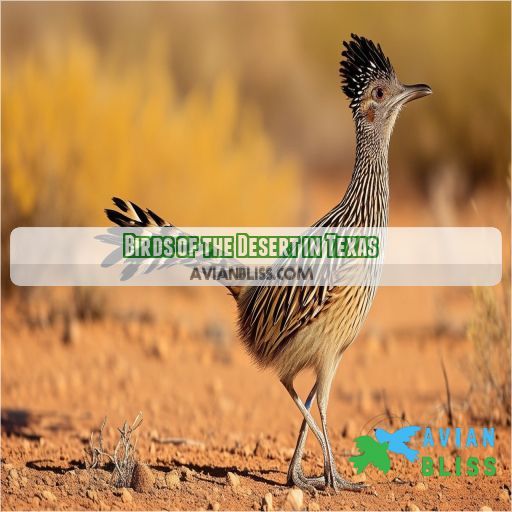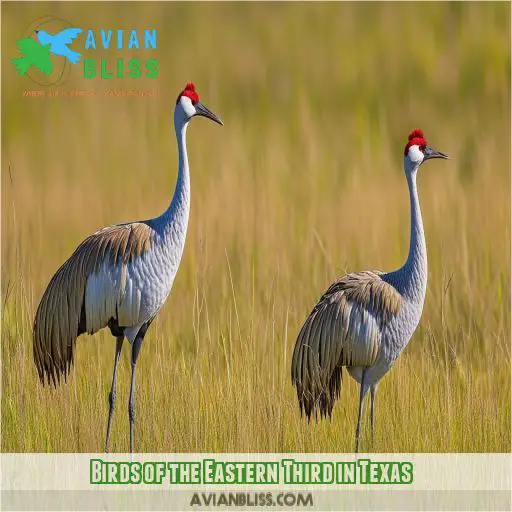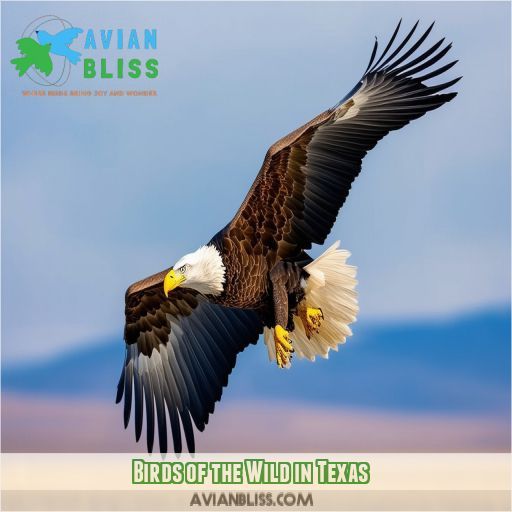This site is supported by our readers. We may earn a commission, at no cost to you, if you purchase through links.
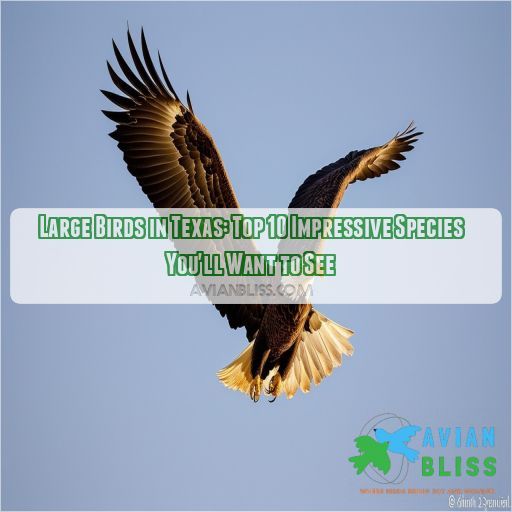
Learn about graceful waterbirds, powerful raptors, and even a few secretive desert inhabitants. By attending to the fine points of these remarkable birds, you’ll find it easier to master bird identification and become more able to appreciate the array of myriad ecosystems in the Lone Star State.
Be prepared to see these impressive large birds in Texas and develop your birding skills
Table Of Contents
- Key Takeaways
- Largest Birds in Texas
- Grey Waterbirds in Texas
- White Cranes in Texas
- Raptors in Texas
- Common Waterbirds in Texas
- Large Birds of Prey in Texas
- Birds of the Desert in Texas
- Birds of the Eastern Third in Texas
- Birds of the Wild in Texas
- Other Large Birds in Texas
- Frequently Asked Questions (FAQs)
- What are the massive birds in Texas?
- What is the big GREY water bird in Texas?
- What are the big white cranes in Texas?
- What are the GREY cranes in Texas?
- How do large birds in Texas adapt to urban environments?
- What conservation efforts protect Texass largest bird species?
- How do climate changes affect large bird populations in Texas?
- What are the migration patterns of Texass biggest birds?
- How do large Texas birds interact with introduced species?
- Conclusion
Key Takeaways
- Texas is a bird-watcher’s paradise, boasting some real feathered heavyweights like the Whooping Crane (standing tall at 5’3"!) and the Bald Eagle (with a wingspan that’ll make your jaw drop).
- From coastal wetlands to rugged deserts, the Lone Star State’s diverse ecosystems are a smorgasbord for our avian friends. You might spot a Great Blue Heron fishing in the shallows or a Golden Eagle ruling the skies of West Texas.
- Conservation efforts are paying off big time! Once-endangered species like the Bald Eagle are making a comeback, proving that sometimes, love birds need a little human help to keep the population soaring.
- Whether you’re a seasoned birder or just spreading your wings, Texas offers a chance to see everything from majestic raptors to quirky desert dwellers. Just remember to bring your binoculars and a sense of wonder!
Largest Birds in Texas
You’ll find some of North America’s largest birds soaring through Texas skies. The Whooping Crane, Bald Eagle, and Golden Eagle stand out as the most impressive giants, each with unique characteristics that make them awe-inspiring to observe in their natural habitats
Whooping Crane
You’ll be awestruck by the whooping crane, Texas’s largest bird and North America’s tallest. Standing at 5’3" with a 7’6" wingspan, these majestic creatures are a sight to behold.
They’re not just big; they’re also rare. Conservation efforts have helped their population rebound, but they’re still a precious sight during migration.
Keep your eyes peeled for these white giants among the herons in coastal wetlands
Bald Eagle
Bald Eagles can be found soaring over the eastern third of Texas. With a wingspan of 7’7" and weighing 12 pounds, these raptors are a sight to behold.
They build massive nests in tall trees near water, dining primarily on fish and waterfowl.
Thanks to conservation efforts, Bald Eagle populations have rebounded. Their 20-30 year lifespan means you might spot the same bird on multiple visits
Golden Eagle
While the Bald Eagle reigns in the east, you’ll find the Golden Eagle ruling the skies of far west Texas.
These majestic raptors boast an impressive wingspan of up to 7’8" and weigh around 10.8 lbs. They’re true kings of the desert, soaring over rugged terrain in search of prey.
Watch them hunt with incredible speed and precision, swooping down on rabbits, ground squirrels, and even other birds
Grey Waterbirds in Texas
You’ll find two impressive grey waterbirds in Texas: the Great Blue Heron and the Sandhill Crane. These large, long-legged birds are easily recognizable by their distinctive silhouettes and can often be spotted wading in shallow waters or stalking prey in wetlands across the state
Great Blue Heron
Transitioning from the giants of the feathered world, we’ll now take a closer look at the grey waterbirds of Texas. Among them, great blue herons are a stately vision in any wetland found throughout the state. These are birds that have mastered the art of patience and precision. Here is all you need to know:
- Habitat: Freshwater and marine
- Food: Fish, amphibians, and small mammals
- Courtship: Elaborate displays involving neck stretching and bill clapping
- Protection : Included in the Migratory Bird Treaty Act
Sandhill Crane
You’ll be amazed by the Sandhill Crane, a striking grey waterbird that calls Texas home. These large birds stand up to 4 feet tall and have a wingspan of 6-7 feet.
During migration, you’ll hear their distinctive trumpeting calls echoing across the sky.
They’re omnivores, feasting on everything from seeds to small animals in wetlands and grasslands.
Watch for their elaborate mating dances in spring!
White Cranes in Texas
While Texas does have impressive grey waterbirds, it’s the white cranes that are the most appealing to the imagination. You’ll surely be awestruck by this — the whooping crane; it’s the tallest bird in North America and stands impressively at 5’3" with a 7’6" wingspan. This magnificent bird migrates to spend winters in Texas’s coastal wetlands, where they can be viewed. It’s truly a rare sighting; since conservation efforts increased their numbers, they remain few in number.
Don’t get them mixed up with other white waders, such as a great egret, snowy egret, or wood stork. Add a little variety with the roseate spoonbill; after all, a little pink never hurt anyone. Maybe you’ll be one of the few who sees a white-faced ibis
Raptors in Texas
You’ll find two impressive raptors in Texas: the Red-tailed Hawk and the Osprey. These birds of prey showcase the state’s diverse avian population, with the Red-tailed Hawk known for its widespread presence and the Osprey recognized for its unique fishing abilities
Red-tailed Hawk
While white cranes impress with their elegance, the red-tailed hawk is equally impressive. This versatile bird of prey is common throughout Texas, easily identifiable by the red band on its tail and its shrill calls as it circles in the sky.
Look out for its excellent hunting skills and breeding habits in a wide range of different environments. Their great adaptability makes them a year-round feature in the skies of the Lone Star State
Osprey
Let’s shift from our focus on the Red-tailed Hawk and dip into the exciting world of the Osprey. The fish-eating raptor is a wonder to behold in Texas. You’ll be amazed by their:
- Impressive wingspan of 5-6
- Special capability of diving into water feet first
- Reversible tip outer toe for gripping slippery fish
- Distinctive dark eye stripe
Ospreys are superbly adapted birds, the features of which make them great fishermen. You’re likely to frequently see them around lakes and coastal areas with hunting ability in action.
Common Waterbirds in Texas
You’ll find the Snowy Egret and Tricolored Heron among Texas’s common waterbirds, both offering striking displays of plumage and behavior. These wading birds can be spotted in various wetland habitats across the state, from coastal marshes to inland lakes and rivers
Snowy Egret
You’ll be captivated by the snowy egret, a medium-sized wader that’s a common sight in Texas wetlands. With its pristine white plumage and distinctive yellow feet, it’s a striking bird to observe.
Standing at about 2 feet tall and weighing just over a pound, this graceful creature boasts a wingspan of up to 41 inches.
You’ll find them wading in shallow waters, expertly hunting small fish and crustaceans
Tricolored Heron
The Snowy Egret is a beautiful bird because of its all-white body, but the Tricolored Heron can be even more spectacular. It has a very slim build, and its irreplaceable blue-gray, lavender, and white color traditionally occupy one of the most abundant places among the numerous inhabitants of Texas wetlands. You’ll undoubtedly be charmed:
- Stealthy hunting techniques
- Elaborate courtship
- Incredible aerial acrobatics
- Unique defensive postures
Watch this stately bird stalking fish in shallow waters, showing adaptability and grace with moves among other herons and egrets.
Large Birds of Prey in Texas
Now, let’s look at the leaders up in the sky after beholding the grace of the waterbirds. Texas has some of the most giant birds of prey, each with unique methods of hunting and prey choices. Swooping vultures to mouse-hunting, silent owls rule over the skies through plenty of ecosystems in Texas.
| Specie | Diet | Nesting Habit |
|---|---|---|
| Bald Eagle | Fish, waterfowl | Large stick nests in trees |
| Osprey | Almost exclusively fish | Platform nests near water |
Great Horned Owl Small mammals, birds Tree cavities, abandoned nests
You can see these magnificent hunters in several habitats, from coastal areas to forests. Some, like the Magnificent Frigatebird, pass through during migration season. Others, such as falcons, reside there the entire year. The nests can be substantial stick constructions in trees or up to repurposed cavities. However, with more excellent knowledge of their habitats and behaviors, you’ll get the best luck spotting these incredible birds in the wild.
Birds of the Desert in Texas
Moving from birds of prey to the desert, you’ll find a unique avian world in West Texas. The Golden Eagle reigns supreme here, adapting perfectly to the harsh environment. You’ll spot these majestic creatures soaring over rugged landscapes, their 7’8" wingspan a sight to behold.
But they’re not alone. The American Avocet and Black-necked Stilt wade through shallow waters, their long legs suited for foraging. Keep an eye out for the Marbled Godwit and Long-billed Curlew, both masters of camouflage in the desert terrain. If you’re lucky, you might glimpse the American Oystercatcher, one of the rarest desert birds in Texas.
These species have evolved remarkable adaptations to thrive in arid conditions. To see them, head to popular West Texas birding sites like Big Bend National Park or the Davis Mountains.
You’ll be amazed at the diversity of desert birds Texas offers
Birds of the Eastern Third in Texas
Moving from the arid landscapes of western Texas, let’s soar into the lush eastern third of the state. Here, you’ll encounter a diverse array of large birds, including the majestic bald eagle. These raptors thrive in the region’s abundant waterways and forests, making it an ideal bald eagle habitat.
You’ll be captivated by:
- The sight of a bald eagle swooping down to catch fish
- The sound of pelicans’ wings slapping the water as they dive
- The graceful silhouette of a great blue heron against the sunset
- The impressive size of a double-crested cormorant drying its wings
- The unexpected appearance of a northern gannet far from its usual coastal haunts
Bald eagle conservation efforts have been successful, and you’re likely to spot these impressive birds year-round. During bald eagle migration, numbers increase as northern birds join the local population. Keep an eye out for brown pelicans and wood storks too, adding to the eastern third’s avian spectacle
Birds of the Wild in Texas
When you venture into Texas’s wild spaces, you’ll encounter some truly magnificent birds.
The whooping crane, a conservation success story, stands tall at 5’3" and can be spotted in coastal areas during winter migrations. Bald eagles, with their impressive 7’7" wingspan, have made a comeback and now nest throughout the eastern third of the state. In the rugged west, golden eagles build massive nests on cliff faces, ruling the desert skies.
Keep an eye out for diverse waterfowl like geese, ibises, and pelicans in wetland habitats. Cormorants and bitterns add to the mix, each playing a unique role in Texas’s ecosystems.
As you observe these wild birds, you’ll gain a deeper appreciation for their impact on the environment and the intricate migration patterns that bring them to the Lone Star State
Other Large Birds in Texas
While exploring Texas’s bird diversity, you’ll encounter impressive species beyond the largest ones. The Great Horned Owl, Wild Turkey, and Peregrine Falcon are notable large birds that contribute to the state’s rich avian fauna, each with unique characteristics and habitats
Great Horned Owl
While exploring Texas’s wild birds, you’ll want to keep an eye out for the impressive Great Horned Owl. These nocturnal hunters are masters of stealth and power. Here are four key facts about these magnificent birds:
- Striking yellow eyes
- Distinctive "horned" ear tufts
- Diverse diet, including small mammals and birds
- Adaptable to various habitats, from forests to urban areas
Their hunting techniques are truly remarkable, using silent flight to ambush prey
Wild Turkey
You’ll spot wild turkeys strutting their stuff across Texas landscapes. These hefty birds boast impressive fan-like tails and iridescent feathers.
During mating season, males puff up and gobble to attract hens. Their diet includes insects, seeds, and berries.
While they thrive in diverse habitats, conservation efforts have boosted populations.
Keep an eye out for these majestic birds, especially on the Bolivar Peninsula, where they’re known to roam
Peregrine Falcon
While the Wild Turkey‘s impressive size may catch your eye, the Peregrine Falcon’s speed will leave you breathless. These raptors are built for high-speed pursuit, diving at over 200 mph to catch prey like northern shovelers or green-winged teals.
You’ll find them nesting on cliff faces or tall buildings, adapting to both natural and urban habitats.
Their mating displays are a spectacular aerial dance you won’t want to miss
Frequently Asked Questions (FAQs)
What are the massive birds in Texas?
Like giants soaring through Texas skies, you’ll find three massive avian rulers: the towering Whooping Crane, standing 5’3" tall; the majestic Bald Eagle, with a 7’7" wingspan; and the powerful Golden Eagle, weighing up to 8 lbs
What is the big GREY water bird in Texas?
You’re likely spotting the Great Blue Heron. It’s a tall, long-legged wader with blue-gray plumage. You’ll often see it standing motionless in shallow waters, patiently waiting to strike at fish with its sharp beak
What are the big white cranes in Texas?
Picture graceful giants, gliding through Texas skies. You’ll spot Whooping Cranes, standing tall at 5’3" with a 7’6" wingspan. These majestic birds, North America’s tallest, can be seen in the wild, embodying nature’s awe-inspiring beauty
What are the GREY cranes in Texas?
You’ll spot Sandhill Cranes in Texas, especially during winter. These tall, gray birds with distinctive red crowns gather in large flocks, often found near water where they can search for fish. They’re known for their unique trumpeting calls and graceful courtship dances in open fields
How do large birds in Texas adapt to urban environments?
Did you know 85% of urban birds are adaptable species? You’ll find large birds in cities modifying their diets, nesting in buildings, and becoming less fearful of humans. They’re learning to thrive alongside us, showing impressive resilience
What conservation efforts protect Texass largest bird species?
You’ll find conservation efforts focused on habitat preservation, breeding programs, and public education. Texas Parks and Wildlife leads initiatives to protect whooping cranes, bald eagles, and golden eagles through monitoring, research, and law enforcement
How do climate changes affect large bird populations in Texas?
You’re about to uncover a chilling truth. Climate changes disrupt migration patterns, alter food availability, and shrink habitats. Rising temperatures affect breeding cycles, while extreme weather events can devastate nesting sites. These impacts threaten Texas’s majestic avian giants
What are the migration patterns of Texass biggest birds?
You’ll notice Texas’s largest birds follow distinct migration patterns. Whooping cranes journey from Canada to the Gulf Coast each winter. Bald eagles often move south within the state, while golden eagles may travel to Mexico
How do large Texas birds interact with introduced species?
Picture a majestic bald eagle soaring above a bustling pond. You’ll notice it competing with invasive nutria for fish. Texas’s large birds often adapt to introduced species, sometimes altering their hunting habits or nesting locations to coexist
Conclusion
Like an avian tapestry of impressive proportions, Texas stretches out before you. From the towering Whooping Crane to the fierce Golden Eagle, you have wandered through ten remarkable species that call this Lone Star State their own.
You’re now better armed with the ability to recognize these beautiful creatures that move around the varied ecosystems in Texas. Whether you’re sweeping wetlands of existing coasts or scouring desert landscapes, keep your eyes peeled for these large birds in Texas.
They’re living testaments to the state’s rich biodiversity and are sure to enhance any birding adventures


